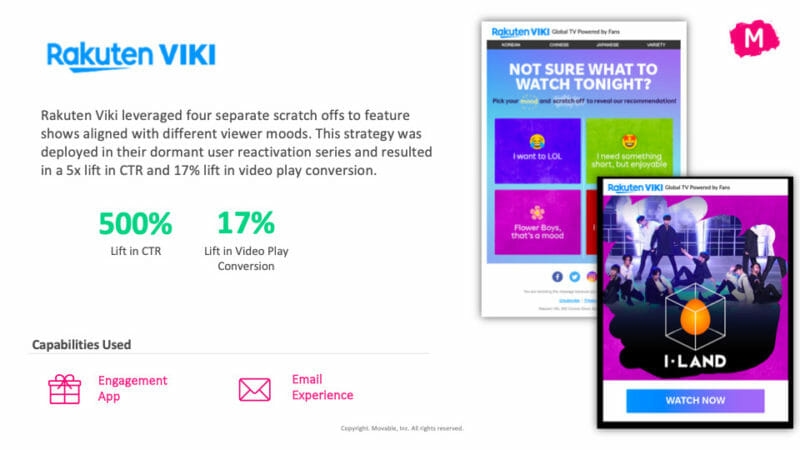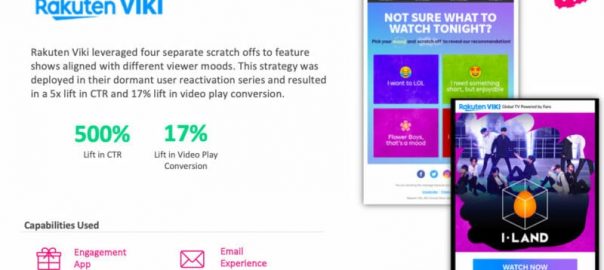A martech stack featuring Movable Ink and Braze is critical to user engagement.
If you’re not familiar with “Healer,” “W” or “My Love From the Star,” and your heart doesn’t beat faster at the mention of Ji Chang-Wook, the chances are you’re not a fan of K-dramas. But there are many such fans, not just in South Korea, but here in the United States and around the world. Catering to the bottomless appetite for Korean and other Asian TV and movie content is Viki, a division of Rakuten.
How big is Viki’s audience? “Millions and millions and millions,” said Karen Paek, laughing. Viki has nine or ten million followers across the main social platforms, Paek recalled, but the company does not publicly share audience numbers for its actual service.
“We’re a service that’s global,” said Paek. “We have users in Europe; we have a very large user base in Latin America, so we have a lot Spanish and Portuguese-speaking viewers. Our dramas are subtitled in almost every language.”
Paek is Director of Integrated Marketing for Viki, and we asked her about her mission. “There’s user acquisition — we’re still definitely in hyper-growth mode,” she said. “An unfortunate benefit of the pandemic has been a huge surge in the number of users we have: people are staying at home, they’re streaming, so streaming businesses have done very well.”
From acquisition to engagement. In addition to user acquisition, where the U.S. remain a priority market, Paek is focused on engagement and retention, creating journeys for new users in the hope of converting them into subscribers. Viki has an ad-supported free model as well as an ad-free subscription model. Subscribers also get access to movies, which are all behind the paywall, as well as priority access to new content.
“What we see is, the more often a user comes to visit us, and for longer periods, the more likely they are to eventually become a subscriber. My team’s job is to create these more customized, segmented journeys,” said Paek. Localization is important, messaging users in their preferred language. “If we know that you live in Brazil, the top five [shows] viewers are watching is different from the top five in the U.S. or Canada, then we’re going to be promoting different content for you.”
Paek’s team is responsible for social media, interacting with users primarily through Facebook, Twitter and Instagram.
What’s in your stack? Martech is critical in enabling a relatively lean team (two members in the U.S. and two in Korea) to serve such a large and diverse audience. “We’ve been on Braze a little over a year now. We were formerly using Iterable, but we were seeing so much growth, and as we were scaling we felt the need to move to a more robust platform.” Braze is a customer engagement platform offering cross-channel personalization, AI-driven optimization, and lifetime engagement orchestration.
“I brought Movable Ink into the mix more like a year and a half ago. I was previously at a publishing company called Time Inc., which is now Meredith, and we were leveraging a lot of Movable Ink capabilities, which was a positive experience.” Movable Ink has helped with operational efficiencies, but also enabled more engaging, personalized, interactive creative content which the in-house team would not have been able to produce themselves.
The marketing team’s product, including descriptions of shows, is typically translated into ten languages using the translation service Gengo. The team is not using a social media management tool.
Viki’s choice of channels. The three leading channels for user engagement are emails, push notifications, and in-app messages. “In-app messages, and being able to promote to our users who are coming to visit, has provided a lot of impact and value.” The messages can appear as pop-ups or content cards within the feeds, both features enabled by Braze and customized for users. “The in-app channel has been amazing for us, but email and push are still important, especially for resurrecting dormant users who haven’t been to the app in a while.”
Engagement, Paek told us, is skewing strongly to mobile. “Most of our users are consuming content on mobile devices whether that be a tablet or phone, but we are also seeing more growth on the TV front, whether people are using Apple TV or Fire [or other] smart TVs.”
Use cases for Movable Ink. Originally known for dynamic email content, rendering at time of opening, Movable Ink now offers a broader range of personalized visual experience outside the email channel. In the summer, Viki launched a new feature called Watch Parties, where multiple visitors could watch a drama in real time, and chat about the action. “We wanted to create a lot of buzz, and also wanted people to remember to join. We used Movable Ink’s countdown timer and add-to-calendar.”
Read about Barnes & Noble leveraging Movable Ink for BOPIS.
Another Movable Ink feature which has performed well has been live polls about series or cast members, which can be executed in emails or in-app. “That creative did very well for us across a few series we have. Another one that did really well is the scratch-off feature.” Both in emails and in-app messages, Viki promoted discounts: “Scratch-off to reveal your discount,” said Paek. “Our opens and clicks, whenever we used any of those types of creatives, are so much higher.” Conversions too: “Those are big wins for us.”

Use cases for Braze. “Braze is really our messaging service,” said Paek. “We use Braze to help create these different journeys for our users. Obviously there’s a lot of data engineering work that goes into play where we need to ingest whatever attributes or events are needed to trigger who we want to target, and then Braze takes it from there. We create our emails through Braze, set up our push notifications, and create multi-channel campaigns.”
For new users, registration triggers a custom series including a welcome email on day one, then push notifications. “We’re definitely predominantly mobile, and I think Braze are the experts in terms of mobile messaging.” Braze enables not just text-based push notifications, but notifications containing images and even video for phones eligible to receive them.
“The biggest reason why we decided to use them, although we are still working on rolling this out,” said Paek, “is in helping to automate a lot of the notifications we want to go out to our users. If a user has finished watching one particular series, we want to immediately suggest something at that moment. People are finishing at different times on different days. One of the things Braze is going to help us with is being able to automate something like that so it’s less burden on our engineering teams to develop that technology.
Read about Braze’s 2020 platform enhancement.
Segmentation beyond location. Clearly Viki knows where its users are, and what content they’ve consumed. Are other attributes important? “Right now we segment users based on when they registered, how often they are visiting. We also segment based on whether a user has just signed up for a seven-day free trial, if a user has canceled their subscription (then you’re in our win-back series); and we drill down further into which subtitle language you selected, which plan did you pick, and within those plans, are you premium, mid-tier or basic. The sky is the limit.”
Paek has also seen success with check-out abandonment re-targeting. If a user lands on a plan page or check-out page but doesn’t convert, that can trigger a reminder message.
Seeking virality. The importance of social media engagement relates to word-of-mouth. “We’re trying to create more virality, more sharing,” said Paek, “because what we know from research and surveys is a lot of people hear about watching Asian dramas through a friend or family member. Word-of-mouth is probably the top source of new user conversion for us.”
It’s also clearly possible to learn about it through an article on MarTech Today.
This story first appeared on MarTech Today.
Marketing Land – Internet Marketing News, Strategies & Tips
(69)
Report Post





